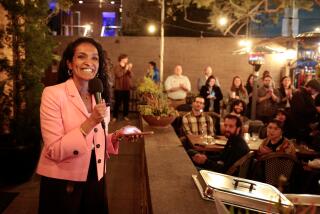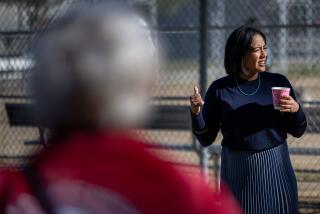Who should shape neighborhood councils? The debate intensifies
They’ve been dubbed “Starbucks stakeholders,” derided as modern-day carpetbaggers because they vote in Los Angeles neighborhood council elections even if all they’ve bought in the area is a cup of coffee, rather than a house or a business.
Although the term is fairly new in Los Angeles’ political vernacular, the concept has become the focus of a decade-long debate over just who the city’s nearly 100 advisory councils represent, and how vulnerable they are to special-interest “takeovers.”
The councils are designed to be broadly democratic and open to almost anyone. But City Councilman Jose Huizar recently proposed limiting the voting power of people with only tenuous connections to a community.
Two months ago, a bitter neighborhood council election in Eagle Rock — a community represented by Huizar — reignited the debate over who should be able to vote. Marijuana dispensaries and their allies were accused of mobilizing outsiders to sway the outcome. At stake was an ongoing battle over the dispensaries; activists touted a slate of candidates for the panel, which had previously urged City Hall to curb the growth of pot shops.
Since 2008, city rules have allowed anyone who does business in a neighborhood to cast a ballot as a “factual basis stakeholder,” and at least one union organizer has urged supporters to buy “gas, coffee, whatever” and show the receipt to vote.
Eagle Rock resident Shauna Smith saw one especially strange flier on election day. Below the slate of pro-dispensary candidates was an offer printed in colorful lettering: $40 worth of marijuana in exchange for voting in the race.
“I was livid,” said Smith, whose husband also ran for a seat on the council but lost. “There’s lots of issues facing Eagle Rock. This shouldn’t be the defining one.”
Although she favors legalizing the drug with proper regulation, Smith filed an election challenge and learned that more than one-third of Eagle Rock’s 800 voters that day were outsiders. In the last election, only 101 people voted.
The city agency overseeing this year’s elections said there’s not much they could have done in the Eagle Rock election. “I am supposed to make it easy to vote and hard to cheat,” said Stephen Box, who helped coordinate the elections for the city’s Department of Neighborhood Empowerment. He pointed out that nearly 500 people who live, work or own a business in the area voted, calling it a “success story.”
Only two of the slate’s eight candidates were elected in the Oct. 13 contest. But the episode has prompted some people to ask whether L.A.’s experiment with this microcosm of democracy is working.
Born out of the ideals of openness and inclusion, the neighborhood councils were partly an effort to appease the San Fernando Valley residents who in 2002 attempted to sever ties with Los Angeles and form a separate city.
City leaders hoped the councils would give L.A.’s far-flung neighborhoods a voice beyond the marbled corridors of City Hall. Today, the obscure and localized panels meet in school auditoriums and churches. They have acquired business cards and annual budgets, and some have their own press officers for increasingly sophisticated PR machines. But the volunteers often lack expertise, and a handful of councils have been plagued by infighting.
Tales of voting shenanigans are plenty, some told and retold to the point of urban legend.
There’s the one where Venice resident Raku, a black Labrador, cast a ballot. Allegations of children voting are perennially lobbed post-election.
In 2004, a developer of the 1,000-acre Playa Vista community bused its construction workers, some from as far away as Riverside County, to a neighborhood council election in Westchester. They arrived, some clutching a flier that urged them to bring their pay stubs and promised “Free food! Free beer!” afterward.
The developer insisted that its workers were legitimate stakeholders whose jobs depended on the neighborhood. But many local residents said the developer had stolen the vote, adding several Playa Vista supporters to the council.
The experience left many disillusioned, said Rex Frankel, a local resident who has opposed Playa Vista in numerous lawsuits. “The community doesn’t get involved with the council,” choosing to participate in other groups instead, he said.
“You really pervert the process when you allow anyone to come in because they have a singular interest to vote for a day,” said Doug Haines, a member of the East Hollywood Neighborhood Council, who said his own council has been targeted by slates of candidates, some them non-residents, friendly to development and liquor stores.
Haines, like many others who participate in neighborhood councils, pays close attention to city politics and regularly attends City Council meetings. He speaks passionately against development projects and frequently sues to stop them.
Every morning, he walks the streets of his neighborhood — picking up trash, removing graffiti — and is frustrated with the idea that people without true stakes in the neighborhood council can outcomes. “It really poisons the authenticity of the system,” he said.
Mark Haskell-Smith, who ran on the Eagle Rock slate, said dispensary patrons, many of whom live outside Eagle Rock, are no different from gym members. “If someone on the neighborhood council has made it their mission to close the place they get their medicine, that affects their lives,” he said, “even if they live next door in Echo Park.”
Greg Nelson, who once headed the city agency that oversees the councils, said that if people have the energy and desire to serve on multiple neighborhood councils, they should. The founding philosophy of the councils was to maximize participation, he said. “This isn’t about one man, one vote.”
Neighborhood council boards range in size from nine members to 45. Huizar has proposed limiting the number of seats that at-large stakeholders can influence to two.
But making that change could be a daunting task. Each council has its own bylaws and defines stakeholders differently.
“The basic challenge is how to keep the doors open for participation in neighborhood councils without jeopardizing the integrity of what they do,” said Raphael Sonenshein, executive director of the Pat Brown Institute of Public Affairs at Cal State Los Angeles.
Sonenshein, an early architect of the councils, said his heart sank when he read about the “Starbucks stakeholders” in Eagle Rock’s election. “That certainly was not the original idea, that you’d go organize people to come in who don’t have a basic stake in the district,” he said.
But sifting the sincerely interested people from the rest can be problematic. “Who’s going to make that decision?” Sonenshein said.
Despite the complications, Sonenshein is encouraged, saying power struggles like these demonstrate the panels’ growing ability to sway city leaders and private interests. “If these were empty vessels, nobody would go to the trouble to stretch the rules.”
More to Read
Start your day right
Sign up for Essential California for news, features and recommendations from the L.A. Times and beyond in your inbox six days a week.
You may occasionally receive promotional content from the Los Angeles Times.







